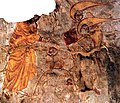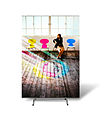Introduction

The visual arts are art forms such as painting, drawing, printmaking, sculpture, ceramics, photography, video, filmmaking, comics, design, crafts, and architecture. Many artistic disciplines, such as performing arts, conceptual art, and textile arts, also involve aspects of the visual arts, as well as arts of other types. Also included within the visual arts are the applied arts, such as industrial design, graphic design, fashion design, interior design, and decorative art.
Current usage of the term "visual arts" includes fine art as well as applied or decorative arts and crafts, but this was not always the case. Before the Arts and Crafts Movement in Britain and elsewhere at the turn of the 20th century, the term 'artist' had for some centuries often been restricted to a person working in the fine arts (such as painting, sculpture, or printmaking) and not the decorative arts, crafts, or applied visual arts media. The distinction was emphasized by artists of the Arts and Crafts Movement, who valued vernacular art forms as much as high forms. Art schools made a distinction between the fine arts and the crafts, maintaining that a craftsperson could not be considered a practitioner of the arts. The increasing tendency to privilege painting, and to a lesser degree sculpture, above other arts has been a feature of Western art as well as East Asian art. In both regions, painting has been seen as relying to the highest degree on the imagination of the artist and being the furthest removed from manual labour – in Chinese painting, the most highly valued styles were those of "scholar-painting", at least in theory practiced by gentleman amateurs. The Western hierarchy of genres reflected similar attitudes. (Full article...)
Selected article

The Garden of Earthly Delights (Dutch: De tuin der lusten, lit. 'The garden of lusts') is the modern title given to a triptych oil painting on oak panel painted by the Early Netherlandish master Hieronymus Bosch, between 1490 and 1510, when Bosch was between 40 and 60 years old. Bosch's religious beliefs are unknown, but interpretations of the work typically assume it is a warning against the perils of temptation. The outer panels place the work on the Third Day of Creation. The intricacy of its symbolism, particularly that of the central panel, has led to a wide range of scholarly interpretations over the centuries.
Twentieth-century art historians are divided as to whether the triptych's central panel is a moral warning or a panorama of the paradise lost. He painted three large triptychs (the others are The Last Judgment of c. 1482 and The Haywain Triptych of c. 1516) that can be read from left to right and in which each panel was essential to the meaning of the whole. Each of these three works presents distinct yet linked themes addressing history and faith. Triptychs from this period were generally intended to be read sequentially, the left and right panels often portraying Eden and the Last Judgment respectively, while the main subject was contained in the centerpiece. (Full article...)
Selected picture

Selected quote
| “ | Painting is easy when you don't know how, but very difficult when you do. | ” |
| — Edgar Degas, unknown |
Related portals
Selected biography
Pierre-Auguste Renoir (/rɛnˈwɑːr/; French: [pjɛʁ oɡyst ʁənwaʁ]; 25 February 1841 – 3 December 1919) was a French artist who was a leading painter in the development of the Impressionist style. As a celebrator of beauty and especially feminine sensuality, it has been said that "Renoir is the final representative of a tradition which runs directly from Rubens to Watteau."
He was the father of actor Pierre Renoir (1885–1952), filmmaker Jean Renoir (1894–1979) and ceramic artist Claude Renoir (1901–1969). He was the grandfather of the filmmaker Claude Renoir (1913–1993), son of Pierre. (Full article...)
Did you know (auto generated) -

- ... that The Wiccan Web recommends drawing pentagrams on your computer screen with tinctures?
- ... that The Summer Hikaru Died went from drawings on a Twitter account to receiving three times more orders than copies available in its first print run?
- ... that as a senior in high school, manga artist Yama Wayama began drawing male–male romance manga as a hobby?
- ... that the British rap song "Jiggle Jiggle" by filmmaker Louis Theroux has been used in more than two million TikTok videos?
- ... that Bernie Wrightson spent seven years drawing an illustrated edition of Mary Shelley's 1818 novel Frankenstein?
- ... that in May 1983 British public health physician Spence Galbraith suggested withdrawing blood products made from blood donated in the U.S. after 1978?
- ... that the documentary Lynch/Oz incorporates hundreds of film clips to illustrate the influence of The Wizard of Oz on the work of filmmaker David Lynch?
- ... that art historian Zehava Jacoby was able to suggest a reconstruction of the lost tomb of Baldwin V of Jerusalem, destroyed in an 1808 fire, using an 18th-century drawing by Elzear Horn?
General images
Major topics
- Types of visual art – Architecture • Art intervention • Ceramic art • Computer art • Drawing • Fashion • Film • Installation art • Land art • Mixed media • Painting • Performance art • Photography • Printmaking • Sculpture • Stained glass
- Art history – Pre-historic art • Ancient art • Art of Ancient Egypt • Art in Ancient Greece • Minoan pottery • Scythian art • Roman art • Women artists
- Western art periods and movements – Medieval art • Gothic art • Renaissance • Mannerism • Baroque • Rococo • Neoclassicism • Romanticism • Realism • Modern Art • Impressionism • Symbolism • Fauvism • Proto-Cubism • Cubism • Futurism • Dada • Art Deco • Surrealism • Abstract Expressionism • Lyrical abstraction • Conceptual Art • Contemporary Art • Postmodern art visual arts.
- Eastern and Middle Eastern art – Buddhist art • Chinese art • Islamic art • Japanese art • Laotian art • Thai art • Tibetan art
- Lists – Architects • Art movements • Art periods • Painters • Printmakers • Sculptors • Statues
- Lists of basic topics – Visual arts • Architecture • Film • Painting • Photography • Sculpture
Subcategories

Architecture | Ceramic art | Comics | Crafts | Design | Drawing | Illustration | Film | Glass | Graphic design | Industrial design | Landscape architecture | Multimedia | Painting | Photography | Pottery | Printmaking | Public art | Sculpture | Typography | Mosaic
Artists | Visual arts awards | Artist collectives | Art collectors | Art critics | Art curators | Visual arts exhibitions | Art forgery | Art history | Visual arts materials | Art schools | Artistic techniques |
WikiProjects
Things you can do
Associated Wikimedia
The following Wikimedia Foundation sister projects provide more on this subject:
-
Commons
Free media repository -
Wikibooks
Free textbooks and manuals -
Wikidata
Free knowledge base -
Wikinews
Free-content news -
Wikiquote
Collection of quotations -
Wikisource
Free-content library -
Wikiversity
Free learning tools -
Wiktionary
Dictionary and thesaurus













































































